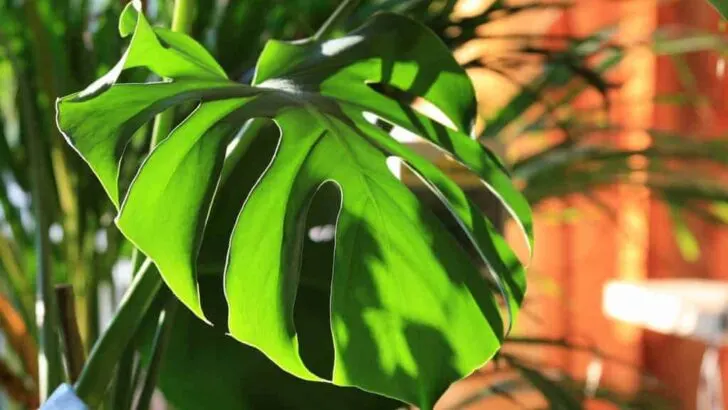Monstera deliciosa, also known as the Swiss Cheese Plant or split-leaf philodendron, is a houseplant with fenestrated foliage belonging to the Araceae family, according to North Carolina University.
It is referred to as the Swiss Cheese Plant because of the holes in the leaves, which people often call fenestrations or slits. There are many theories why the leaves look the way they look, but no one knows precisely why Monstera plants are often fenestrated.
Monstera deliciosa Care Takeaways
| Species | Monstera deliciosa |
| Synonyms | Split-leaf philodendron,fruit salad plant,fruit salad tree, Swiss cheese plant, Mexican breadfruit |
| Family | Araceae |
| Genus | Monstera |
| Growth | Crawl as seedlings, climbing |
| Height | 15 feet |
| Width | 8 feet |
| Soil | Chunky soil mix by adding perlite, peat moss, coconut husk, and orchid bark |
| Watering | Water every 5 to 7 days |
| Light | Bright indirect |
| Temperature | 65 to 80°F |
| Humidity | 50-80% |
| Fertilizer | Fertilize 1 time per month |
| Propagation | Stem cuttings, seeds |
Monstera deliciosa Care
Provide a chunky soil mix using perlite, peat moss, coconut husk, orchid bark to have an airy substrate that retains water well. A Monstera grows best in bright indirect light. Water once the soil is almost dry to the touch about once a week. The optimal temperature lies between 65-80ºF (18-27ºC). Keep humidity above 50%. Fertilize in the primary growing season in spring and summer about every four weeks using a fertilizer with an NPK ratio of 5-2-3. Do not fertilize in autumn and winter.
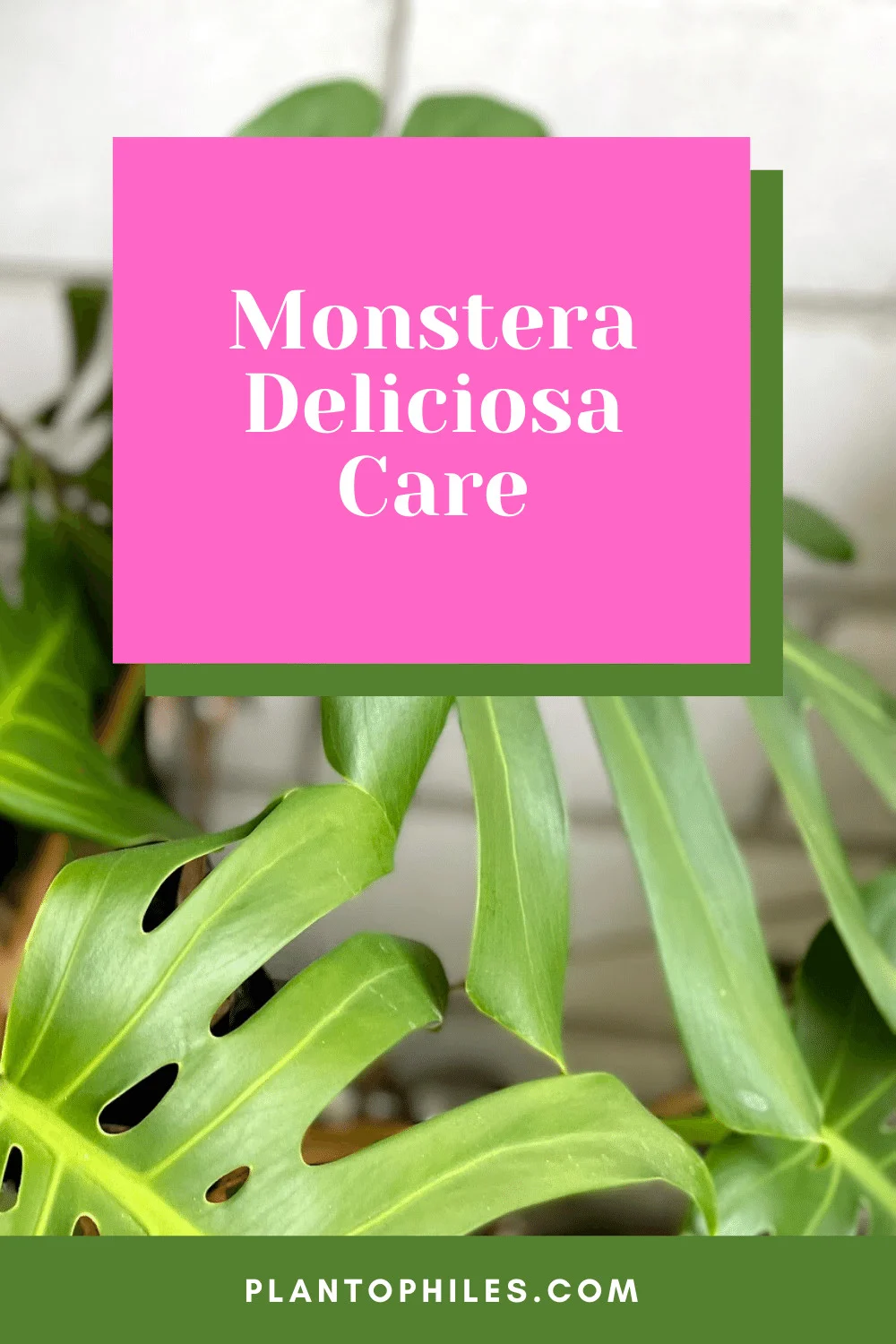
Table of Contents
There are other Monstera, such as the Monstera adansonii, the rare Monstera obliqua, and Monstera epipremnoides, that I each dedicated a plant care article.

They are said to resemble a Swiss cheese called Emmentaler that is famous for its holes (being Swiss, is have to disagree as I cannot see any similarity between a leaf and a milk product. Then again, maybe it is because I am Swiss).
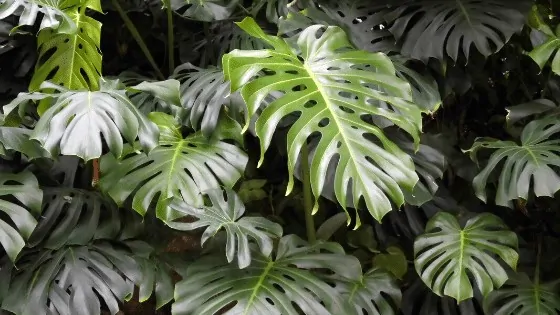
What does the Split Leaf Philodendron, aka the Monstera deliciosa look like?
The Monstera has slits, and they only emerge in more mature plants. The first few leaves are solid and almost heart-shaped, and the Monstera deliciosa starts to produce leaves with slits only after a while.
A highlight for all Monstera lovers is when a new leaf unfurls, which takes a few days. The leaves are light green and change into a darker color once unfurled.
Fun Fact
“Monstera leaves are generally growing toward the light. However, some of the leaves will intentionally be growing away from light sources. This is believed to come in handy in their natural habitat, as it is seen as a way to reach out to other plants and trees that can be climbed.”
Monstera deliciosa Care Sheet
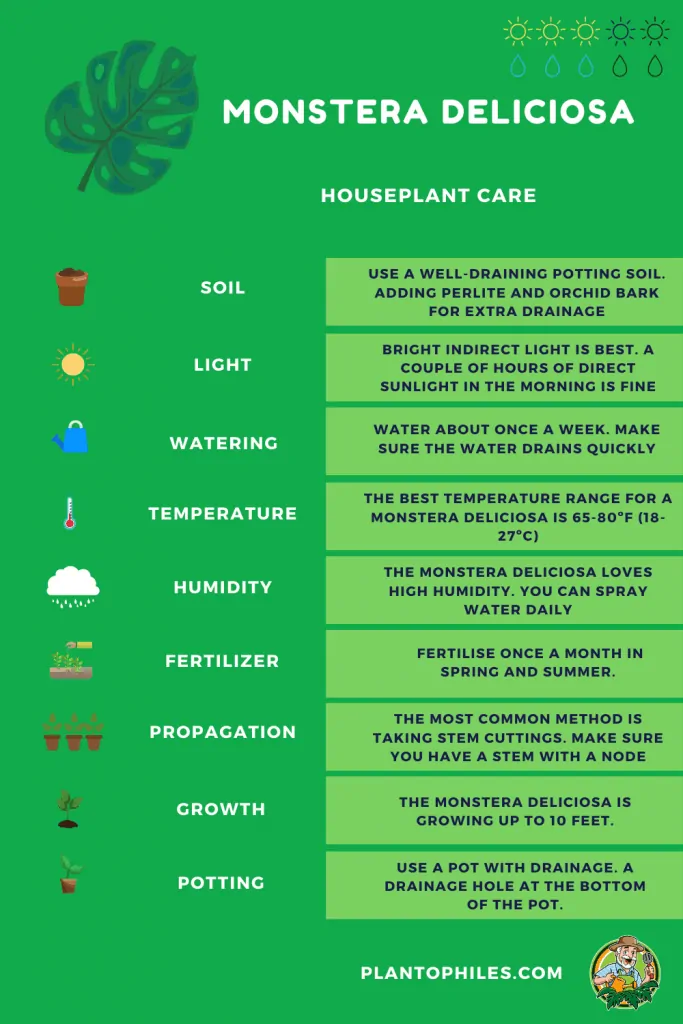
Monstera deliciosa Care Guide – 8 Best Tips!
1. Soil
The Monstera deliciosa thrives in a well-draining potting soil mix, as with most indoor plants.
Add ingredients such as perlite, peat moss, coconut husk, and orchid bark to ensure it is airy and retains water well.
The right soil is really important for your Monstera deliciosa, as too dense soil can lead to root rot.
When soil becomes soggy and stays wet for too long, roots can become mushy and fall off.
Once root rot starts, it quickly spreads to the rest of the roots.
Therefore a great chunky potting mix is a must regarding Monstera Deliciosa care.
2. Light
Monstera deliciosa thrives in bright indirect light. Avoid too much sun as the leaves of a Monstera deliciosa can get sunburned.
You can spot this by watching out for brown spots on leaves and brown leaf tips.
A good location for your Monstera Deliciosa is an east-facing window. A west-facing window is also a good alternative, although 2- 3 hours of direct sunlight in an east-facing window in the morning is fine or beneficial for fast growth.
Place your plant at least 4 feet away as the window can act as a magnifying glass and cause burns.
Read our extensive article to choose the right window direction for your houseplants.
3. Watering
Let the Monstera Deliciosa almost dry out between waterings. Stick your finger about two inches into the dirt to measure if the soil is still humid.
Once the soil is almost dry and won’t stick to your finger, it is time to water.
If it is still wet, do not water it!
You can also make use of a soil humidity sensor if you fancy.
From our experience watering once a week is a great rule of thumb. If needed, you can always water in between.
Monstera Deliciosa will tolerate the occasional watering mistake (mostly overwatering), but make sure that roots do not stay in the water or wet soil for an extended period. This will lead to root rot.
The best water for your Monstera Deliciosa is rainwater. However, not everyone can collect it.
Tap water, as well as distilled water, are fine as well.
You can look at my in-depth article about how to water Monstera deliciosa.
4. Temperature
The optimal temperature lies between 65-80ºF (18-27ºC). As you can see, these plants tolerate various temperatures but will grow slower at low temperatures.
Avoid temperatures below 65ºF (18ºC), as this will stunt the growth of your Monstera deliciosa.
If temperatures stay below 65ºF (18ºC) for too long, your Monstera Deliciosa will wilt and eventually die.
5. Humidity
Monstera Deliciosa loves high humidity. In an ideal case, the humidity lies above the average room humidity.
A humidity of >50% or more is ok.
Anything above 60%, in combination with good airflow, will help your Monstera Deliciosa thrive.
You can use an electronic mister, lay pebble stones in a bowl below the plant, and fill it with water. Another alternative is to manually spritz the leaves of your Monstera Deliciosa from time to time.
However, I want to make one thing clear. Unless you live in the desert, mistreating your Monstera Deliciosa or using a humidifier is most likely unnecessary.
Yes, your Monstera Deliciosa might be happier and grow even better, but you shouldn’t worry too much if you cannot provide very high humidity.
6. Fertilizer
You can fertilize your Monstera deliciosa every 3-4 weeks with a light fertilizer mix with an NPK ratio of 5-2-3. This means 5 parts of nitrogen, 2 parts of phosphorus, and 3 parts of potassium.
This will give the plant the nutrients it needs to become a real Monster as the name implies.
Fertilize once a month during Spring and Summer when your Monstera deliciosa is in its growth phase and stop fertilizing during the autumn and winter months.
For additional information on nutrients and fertilization, you can read our Fertilization guide, which explains everything about the right nutrients and how to fertilize your houseplants.
7. Propagation
Stem cuttings can easily propagate Cheese Plants. To propagate successfully you need a mature stem, and the cut must be done at the aerial root just below a node. Place the cutting in water so it can develop roots.
Additional methods to propagate your Monstera Deliciosa are to put your cutting into the soil directly or use a different medium, such as sphagnum moss or perlite.
Our favorite methods to propagate Monstera Deliciosa are using sphagnum moss or water.
After about 3-4 weeks, you should see roots sprouting from the aerial root and the plant stem.
Make sure to wait until the roots are at least several inches long. The longer the roots are, the bigger the chances your Monstera Deliciosa cutting will do well.
Warning: Do not buy or plant any cutting that does not have a node. A node is a nubby thing coming out of the stem. Without it, it is impossible to grow a new Monstera Deliciosa plant.
The web is full of people posting pictures of cuttings they bought from eBay and other sellers online where you cannot see any node. A cutting with a leaf and a stem is just a cutting with a stem and a leaf. It will never turn into a plant.
Do not hope for a miracle, as it won’t happen. You need at least one node on your Monstera Deliciosa cutting!
With that said, let’s now look into the growth habit of your Monstera Deliciosa.
8. Growth
This is not your average plant that will sit on your windowsill. These plants have the potential to transform your apartment into a proper jungle over a few years.
As Monstera Deliciosa loves to climb, you can provide it with a moss pole that you can get either from Amazon or from a garden center of your choice.
Or you build your moss pole. You can read my tutorial about how to make a moss pole.

You stick it into the soil and attach the stems onto the pole. But please make sure not to hurt the plant during this process and be wise to choose things for attaching the plant that won’t cut into the plant itself.
Check your garden center or Amazon for garden tape or velcro.
If poles are not your thing, you can also try to hinder your plant to grow in all directions by pruning it from time to time. Please refer to the steps outlined under “Propagation.”
In this case, your Monstera deliciosa will grow wider and only gain that much height.
After learning how to care for your Monstera, let us now dive into the origin of the Swiss Cheese Plant.
The origin of the Monstera Deliciosa
The Swiss Cheese Plant is a tropical plant and has its roots – pun intended – in southern Mexico as well as South Panama. You can find it in other tropical areas where it is invasive.
One plant with many names
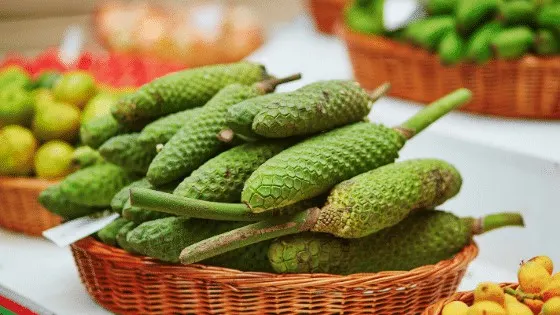
Here you can read more about the Monstera deliciosa fruit.
For fun’s sake, let’s try to list all the names this plant goes by:
- Swiss Cheese Plant
- Monstera Deliciosa
- Delicious Monster (as some call it)
- Hurricane plant
- Mexican Breadfruit plant
- Fruit Salad plant
- Fruit Salad tree
- window leaf
- split leaf philodendron
- or simply the number #1 Office plant of 2018.
Fun Fact: “It is believed that the fenestrations or slits in the plant’s leaves help it to survive strong winds e.g., Hurricanes e.g., the name Hurricane plant. Trustful sources note that further research needs to support this hypothesis.”
Swiss Cheese plant popularity barometer
Rating: Very popular
The Swiss Cheese plant is featured in interior design magazines, and its leaves are also popular in the fashion industry. You can find the split leaves on items from pillows to jewelry pendants to evening robes.
In addition to that, the Instagram hype kicked in quite a bit. The Zeitgeist demands a Monstera Deliciosa in every proper foliage lover’s “urban jungle.”
What about the Variegated Monstera deliciosa?
While the Swiss Cheese plant is very popular, its variegated cousin’s popularity is off the Richter’s scale.
It scores record prices in eBay auctions, and you find the variegated type from sellers on Etsy.
Read more about the Variegated Monstera deliciosa in our article.
In addition, we wrote an article about variegation in Monstera plants and other plants in more general terms.
How does buying a Variegated Monstera Deliciosa online usually work?
Some people even started to sell cuttings directly on Instagram. They sell out even before they have a chance to root.
To get a chance to buy one, you need to comment on the pictures of the cuttings. Reply within seconds to even have the slightest chance to get one of these plants. Otherwise, the plant of your dreams is gone before you know it.
Further, the Swiss Cheese plant was voted the #1most favorite Office Plant of 2018 by Accolade. Runner-ups were the Pilea peperomioides and the Maranta ‘Tricolour.’ It is popular, very popular.
Monstera deliciosa Propagation
There are different methods to propagate a Monstera plant. The most common method is to take cuttings and put them into water.
As Monstera deliciosa grows very big and can grow in all directions, if you are not using a moss pole it might be necessary to trim down your plant occasionally.
As described, the rooting method in water works quite well.
It may take several weeks for the stem to develop roots. This method only works if you cut the stem between an aerial root and below a node.
Sole leaf cuttings without a node will not grow roots so don’t use them to propagate your plant.
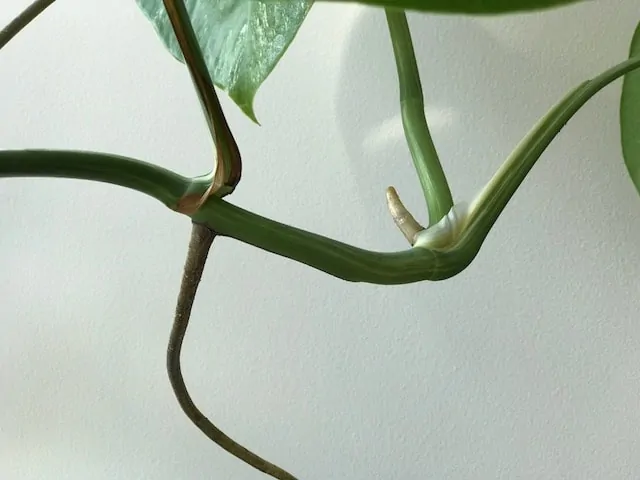
To propagate Monstera deliciosa follow these steps
Step 1: Use a clean knife or scissors and make a clean cut below an aerial node. The cutting should have at least 1 to two leaves.
I heard of others that could propagate it with just the stem, but I would suggest remaining on the safe side.
Step 2: Fill a vase or jar with rainwater or filtered water if possible. This ensures that the water is clean. The water must be neither hot nor cold, as it could hurt the plant.
Make use of room temperature water and fill your vase or jar halfway. When water touches the leaves or you have submerged leaves, this will eventually lead to plant rot.
Step 3: Place the cutting upright and put it in a spot with indirect light.
Step 4: Change the water every few days and wash the plant’s stem. The water mustn’t get old as this can lead to plant rot.
Step 5: Practice patience. In about 4 weeks, you may see the first roots emerge from the stem and the aerial roots. Leave the cutting in the water until a good root system has developed.
Variegation in Monstera deliciosa
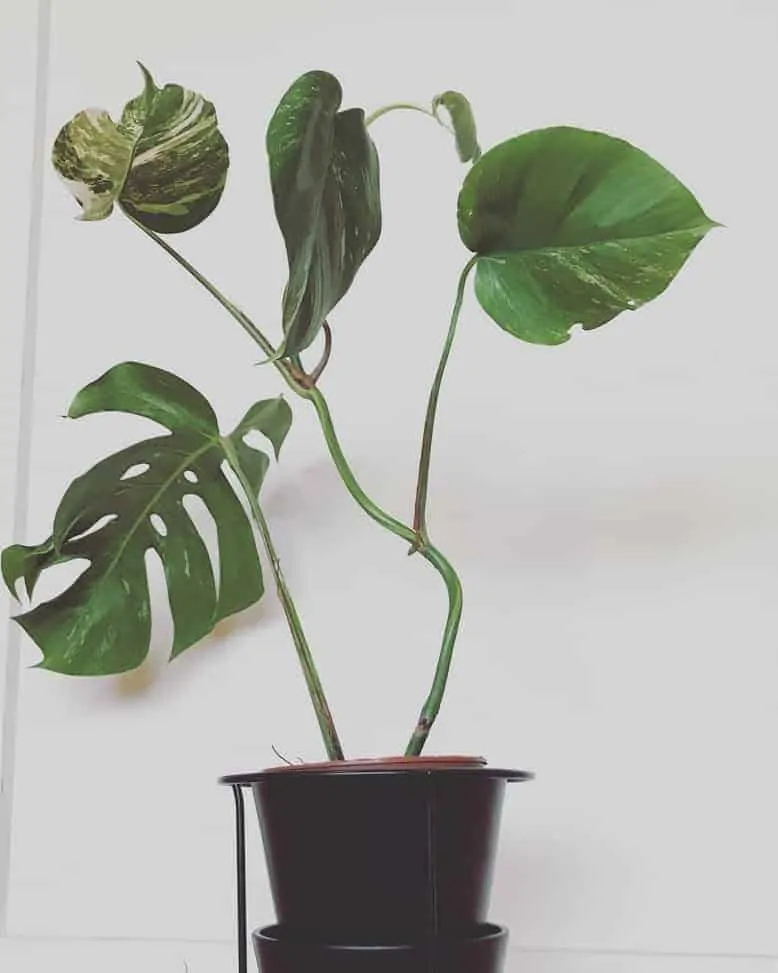
Variegations in Swiss Cheese plants are as stunning as this word is difficult to spell. It often looks like the milkman spilled a can of milk on its leaves. Some leaves are even completely white, while others are split exactly 50/50.
The more intense the variegation, the harder it is for the plant to photosynthesize. White areas are not good for this task and cannot absorb light.
So the whiter the leaves, the harder it is for the Monstera to absorb sunlight.
How to care for variegated plants?
Therefore Variegated Swiss Cheese plants need a tad more sunlight than the green variety and should be put in a spot with bright and mostly indirect light. Be careful, however, as the leaves are more prone to sunburn.
Where to buy a Monstera deliciosa
There are many places where you can buy a Swiss Cheese plant. Most of your local garden centers will have this plan in stock. Also, there are multiple online retailers and plant stores with Monsteras available.
Here is a list of websites where you can buy one:
Amazon.com: Amazon has Swiss Cheese plants in stock, and multiple sellers sell them.
Ikea.com: kea is finally also selling Monstera deliciosa. However, you might not be able to buy the plant online as you must go to the shop and pick it up.
crocus.co.uk: Crocus is a UK site where you can buy this and many other plants. They deliver to the UK as well as to Ireland.
Finding a Variegated Monstera deliciosa can be tricky. These plants are currently in extremely high demand. Instagram fuels the trend using hashtags # such as #monsteradeliciosa and #variegatedmonsteradeliciosa.
You can shop a Monstera deliciosa here.
Sources where you can buy a Variegated Monstera deliciosa
Etsy.com: Multiple sellers occasionally have Variegated Swiss Cheese Plants in stock, depending on how much they can cut from their mother plants.
You may score a fairly reasonable price. However, you have to take the shipping fee into account.
Ebay.com: This is where you may find multiple plants put up for auction. The advantage of Ebay.com is sure that the supply is larger than on other sites.
The disadvantage is that you may pay a price premium as the demand is very high, and many are bidding.
They often mention these auctions on Facebook and other websites where plant enthusiasts are active.
Monstera Deliciosa on Instagram
Multiple people and hashtags fuel the plant craze and the popularity of Swiss Cheese Plants.
Here is a list of the most important hashtags to use, as well as an overview of people to follow:
Common used hashtags: #monstera #monsteramonday #monsteradeliciosa #monsteravariegata
People to follow: monsterafanclub, monsteracoplants, monsteramonstera, monstera.house
The so-called monsteramonday features Monstera plants on Monday. Many people on Instagram post their Monstera plants on Monday and use the hashtag #monsteramonday.
Do Monsteras like misting?
I do not recommend misting Monstera plants as the misting does not lead to more air humidity. Plant leaves that are wet for too long can result in rot and fungus that will start to build up.
Better alternatives to misting are using a humidifier, putting plants closely together, or using a pebble tray with water underneath the pot.
All these alternatives will lead to higher ambient humidity.
Is Monstera deliciosa toxic?
Monstera deliciosa is toxic to humans and pets as it contains toxic calcium oxalates that are not soluble, according to ASCPA. When ingested, it can lead to oral irritation as well as drooling. More severe effects are vomiting and difficulty swallowing.
How to clean a Monstera deliciosa
Clean the leaves of a Monstera plant using a wet cloth every 3-4 weeks, as dust will settle on the upper side of the leaves. This diminishes the ability of leaves to absorb sunlight and the plant to conduct photosynthesis.
To protect your Monstera from plant pests, use neem oil diluted with water or mix water with dishwater soap and rubbing alcohol. A few drops are sufficiently based on my personal experience.
Start by applying the mixture on a small area first and wait half an hour before applying it to other parts of the leaves.
This way you can ensure that the liquid will not damage or burn the foliage.
Always clean your plants in the morning or evening on cloudy days. Direct sunlight could be amplified through the water drops on the leaves and burn the foliage.
Takeaways
- Provide a temperature between 64-81ºF (18-27ºC)
- Use well-draining soil
- Fertilized every four weeks during spring and summer.
- Watering about once a week once the soil is almost dry
- Keep humidity above 60%
- Fertilize every 3-4 weeks with a light fertilizer mix with an NPK ratio of 5-2-3

Daniel has been a plant enthusiast for over 20 years. He owns hundreds of houseplants and prepares for the chili growing seasons yearly with great anticipation. His favorite plants are plant species in the Araceae family, such as Monstera, Philodendron, and Anthurium. He also loves gardening and is growing hot peppers, tomatoes, and many more vegetables.

